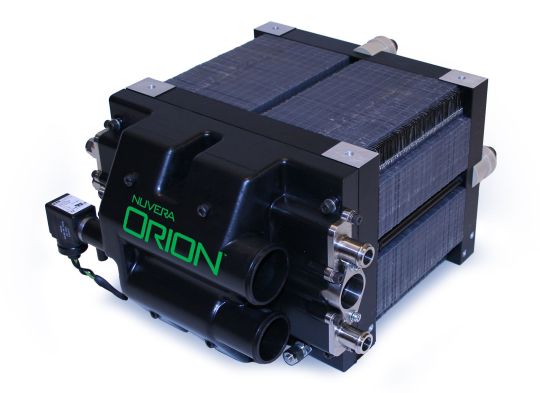#FuelCell
Explore tagged Tumblr posts
Text
For the first time, MIT chemists have mapped out in detail how proton-coupled electron transfers happen at the surface of an electrode. Their results could help researchers to design more efficient fuel cells, batteries, or other energy technologies.
#nanotechnology#hydrogen#sustainability#materialsscience#energy#engineering#future#batteries#fuelcell
19 notes
·
View notes
Text
#FuelCell#Hydrogen#CleanMobility#AutomotiveInnovation#Sustainability#ClimateAction#ZeroEmission#MarketGrowth#FutureOfTransport#powerelectronics#powrmanagement#powersemiconductor
0 notes
Text
#FuelCell#FCEV#SustainableTransport#EVRevolution#GreenMobility#CitroenIndia#CleanEnergy#AutoTech#Timestech#electronicsnews#technologynews
0 notes
Text
#현대디올뉴넥쏘 현대자동차가 7년 3개월여 만에 세대교체한 수소 연료전지 전기차 디 올 뉴 넥쏘를 공개하고 판매를 시작했습니다. 새로운 디자인 언어를 반영한 실내외 모습이 새롭고, 주행 성능과 안전 기능이 폭넓게 향상되었습니다. 특히 1회 충전 주행가능 거리가 700km 이상으로 늘어난 것이 돋보입니다.
#넥쏘#디 올 뉴 넥쏘#FCEV#fuel cell#fuelcell#hydrogen fuel cell#hyundai nexo#수소 연료전지#수소 연료전지 전기차#연료전지#연료전지 전기차#현대자동차#전기 suv#nexo#SUV#the all-new nexo
0 notes
Text

🌍 𝗛𝘆𝗱𝗿𝗼𝗴𝗲𝗻 𝗦𝘁𝗼𝗿𝗮𝗴𝗲 𝗠𝗮𝗿𝗸𝗲𝘁: 𝗣𝗼𝘄𝗲𝗿𝗶𝗻𝗴 𝘁𝗵𝗲 𝗙𝘂𝘁𝘂𝗿𝗲 𝗼𝗳 𝗖𝗹𝗲𝗮𝗻 𝗘𝗻𝗲𝗿𝗴𝘆 🌱
IndustryARC™ updated the market research study on “𝗛𝘆𝗱𝗿𝗼𝗴𝗲𝗻 𝗦𝘁𝗼𝗿𝗮𝗴𝗲” Forecast (2024-2032)
𝐃𝐨𝐰𝐧𝐥𝐨𝐚𝐝 𝐑𝐞𝐩𝐨𝐫𝐭 𝐒𝐚𝐦𝐩𝐥𝐞 : https://tinyurl.com/ysdbw29w
#HydrogenStorage#CleanEnergy#RenewableEnergy#HydrogenFuel#FuelCell#ZeroEmissions#ClimateChange#Sustainability#EnergyTransition#GreenTech
0 notes
Text
Fuel Cell Market: Powering Towards a Clean Future

Fuel Cell Market With a surge in demand for clean energy solutions, the fuel cell market is on the rise. Here is an overview of the global market—US-centric.
Market Size and Growth
Estimates might vary, but most analysts predict that it is going to be a steep climb to a global market value of US$ 12.63 billion by 2031 with a Compound Annual Growth Rate of 27.4%.
US Market Potential
The US holds immense potential within the global scenario. Indeed, it pegs the fuel cell market in the US at US$4.2 billion by 2030, reflecting a strong growth trend. Government support of clean energy and increasing carbon reduction targets set out by countries explain this.
Diverse Dominant Applications
Currently, stationary fuel cells dominate with more than 69% of the global market share in 2023. These are applied in distributed generation facilities, stand-by backup power applications, and combined heat and power systems. However, remarkable growth is bound to take place through the transport sector, mostly for electric vehicles.
Asia-Pacific in the Lead
The Asia-Pacific dominates the global market and holds more than 60% share in 2023. This dominance is due to several factors, such as its large consumer base and rapid development in the hydrogen sector, with the presence of key players like China, Japan, and South Korea.
Business Opportunity
Many different players will open new business opportunities in the fuel cell market, from companies manufacturing components required by fuel cells and electrolyzers that will be used to produce hydrogen, to those building the Hydrogen infrastructure. A big opportunity also lies in the area of research and development of fuel cell technology.
With the fuel cell market growing around the world, the US market is an integral part of this growth. Stakeholders in the market must be ahead of emerging trends to secure these opportunities with the new clean energy source within companies' core applications of transportation and stationary power.
Author Bio -
Akshay Thakur
Senior Market Research at The Insight Partners
1 note
·
View note
Text

New Balance Kawhi 4 - Full Review: https://youtu.be/GewN39Lr2_k?si=SSgCN72DoCfDrb-k
#Kawhi Leonard#New Balance#Sneakers#Basketball Shoes#Kawhi IV#Kawhi 4#Sneakerhead#Review#Unboxing#Shoes#New Shoes#Clippers#Los Angeles Clippers#Sneaker collection#fuelcell#NBA#NBA Playoffs#playoffs#Sports
1 note
·
View note
Photo

Malakas na Paglago sa Merkado ng Hydrogen Fuel Cell Forklifts | www.ceboz.com
Ang merkado ng hydrogen fuel cell forklifts ay patuloy na lumalaki, at inaasahan ang hindi kapani-paniwala na pag-unlad ayon sa bagong ulat. Alamin ang mga dahilan at mga benepisyo ng teknolohiyang ito.
0 notes
Text
This Fuel Cell Lasts Forever and is Powered by Dirt!

Remove the need for expensive solar panels and a long trip around a 100-acre farm swapping out batteries and you make this a lot more accessible. Read More. https://www.sify.com/clean-tech/this-fuel-cell-lasts-forever-and-is-powered-by-dirt/
0 notes
Text

What are 3 real world uses of hydrogen?
Hydrogen Uses
The following list contains three real-world uses for hydrogen, along with details on their potential for growth, use cases, and supporting evidence.
Hydrogen Fuel Cell Vehicles:
Automobiles that run on gasoline or diesel can be replaced by fuel cell vehicles (FCVs) fuelled by hydrogen. Vehicle electric motors in fuel cell vehicles (FCVs) are powered by electricity generated from hydrogen. These vehicles are suitable for use in public transportation, private fleets, and business fleets because they emit zero emissions.
Growth Opportunities: A significant contributor to greenhouse gas emissions is the transportation sector. Hydrogen fuel cell vehicles (FCVs) offer a practical means of lowering carbon emissions because they have no exhaust emissions. It is projected that the global market for hydrogen fuel cell vehicles would expand significantly in the next years.
Use Cases: Fuel cells that run on hydrogen (FCVs) generate energy through a chemical reaction, which powers electric motors. These automobiles have faster refueling times and more range between charges than battery-electric vehicles. The Hyundai Nexo and Toyota Mirai are two examples of commercially available hydrogen fuel cell cars, or FCVs.
Statistics: As of 2021, there were over 10,000 hydrogen fuel cell vehicles (FCVs) in operation globally. Japan is setting the standard for FCV adoption, with the US, Korea, and Germany following closely behind. Significant investments in hydrogen infrastructure and vehicle development are also being made by governments and automakers, demonstrating their strong commitment to the growth of hydrogen fuel cell vehicles (FCVs).
Hydrogen has several real world uses across various industries.
Hydrogen Industrial Applications:
Hydrogen is a common constituent in a wide range of industrial operations. Here are a few specific examples:
Ammonia Production: The Haber-Bosch process, which uses hydrogen to combine nitrogen and hydrogen, produces ammonia, which is mostly used in the production of fertilizer.
Refineries: Hydrogen is used in refineries to remove impurities from petroleum-based goods like diesel and gasoline.
Chemical Industry: Hydrogen is essential to the synthesis of methanol, which is a feedstock for many other chemicals and fuels. It is also used to generate other chemicals, like hydrogen peroxide and hydrochloric acid.
Growth Opportunities: Hydrogen is expected to see an increase in demand due to decarbonization efforts because of its numerous industrial applications. To make methanol, ammonia, and other chemicals, for instance, the chemical industry uses hydrogen. In 2030, the global hydrogen market is predicted to grow at a 5-8% annual rate, according to a McKinsey research, and reach $300 billion.
Use Cases: Hydrogen is a necessary starting ingredient for the production of ammonia, which is mostly used to create fertilizers. Moreover, food, electronics, glass, and metal are processed using hydrogen. It is also used in the refining of oil.
Statistics: As of 2021, more than 60% of the hydrogen required worldwide came from the industrial sector. The production of ammonia alone uses almost half of the hydrogen that is accessible globally.
Hydrogen - Renewable Energy Storage:
Hydrogen is used to store excess renewable energy generation. The process involves converting surplus electricity from renewable energy sources, such as solar or wind power, into hydrogen via electrolysis. The produced hydrogen can be stored and utilized at a later time for a number of uses.
Power Generation: Hydrogen can be utilized in turbines or converted back into power using fuel cells in times when the output of renewable energy is restricted.
Heating: Hydrogen can be used as a fuel for both residential and commercial heating.
Transportation: Fuel that runs on hydrogen can be used to power hydrogen-powered vehicles, including buses, trucks, trains, and cars.
Growth Opportunities: Because renewable energy sources like solar and wind power are intermittent, the grid needs efficient energy storage options. Hydrogen can be used as an energy storage medium to store and consume a lot of renewable energy. According to a report released by Global Market Insights, the global market for green hydrogen is projected to develop at a compound annual growth rate (CAGR) of over 30% in 2021.
Use Cases: Hydrogen can be manufactured via electrolysis from excess electricity generated by renewable sources. The produced hydrogen can be stored and used as fuel for heating, electricity generation, or transportation when the output of renewable energy is low. Decarbonization helps many industries and results in a more sustainable energy system.
Statistics: As of 2021, more than 500 MW of power-to-hydrogen projects had been installed worldwide, with a significant portion of those projects being used for storage of renewable energy. Among the countries that have led the way in putting large-scale power-to-hydrogen projects into action are Germany, Australia, and the Netherlands. Transport, industry, and renewable energy storage are just a few of the uses and expansion opportunities for hydrogen that these images demonstrate. Going forward, the increasing focus on decarbonization and the transition to sustainable energy sources are expected to propel the demand for hydrogen.
Read More- https://www.marketsandmarkets.com/industry-practice/hydrogen/real-world-uses-hydrogen
0 notes
Text
#FuelCell#HydrogenMobility#ZeroEmissions#EVs#IDTechEx#CommercialVehicles#RangeExtenders#SustainableTransport#GreenTech#FutureMobility#powerelectronics#powermanagement#powersemiconductor
0 notes
Text
#Navitas Semiconductor#lightweight#BrightLoop#EVCharging#FuelCell#GaNFast#CleanEnergy#GreenMobility#PowerSemiconductors#Sustainability#FutureOfTransport#Timestech#electronicsnews#technologynews
0 notes
Link
#carbonneutrality#CNH#electrichaultruck#electricminetruck#ElectricVehicle#EV#excavatorfuelcell#FuelCell#Futurride#GeneralMotors#GMHydrotec#hydraulicexcavator#hydrogenfuelcell#Hyundai#JCB#Komatsu#Komatsu930E#Research&Markets#Sany#sustainablemobility#ultra-classhaultruck#XCMG
0 notes
Text
New Balance FuelCell SuperComp Trail Test: Erfahrungen mit dem neuen Trailrace-Schuh

View On WordPress
0 notes

